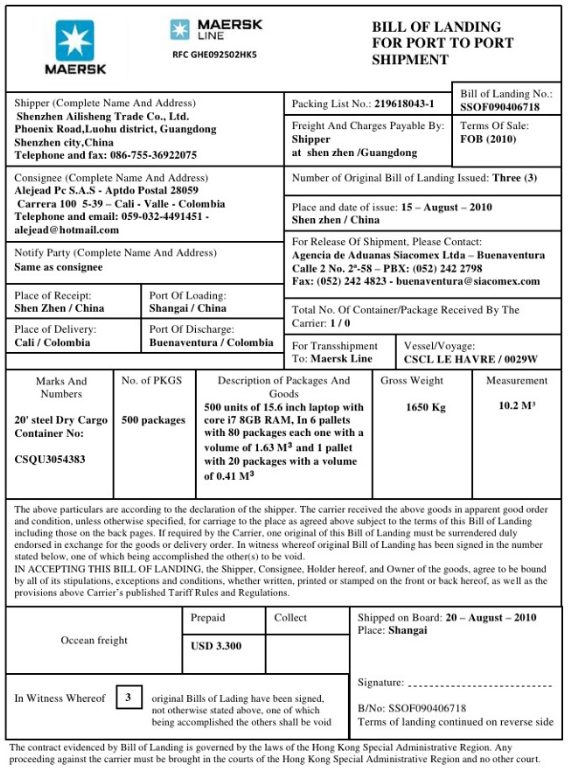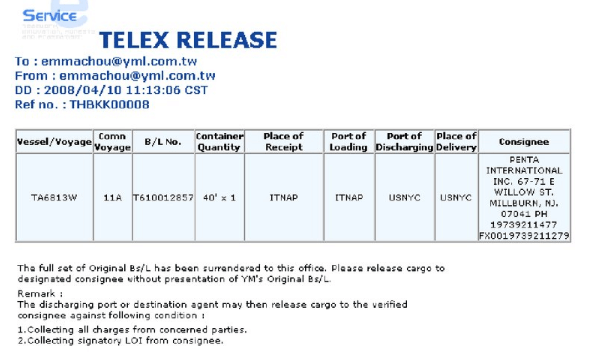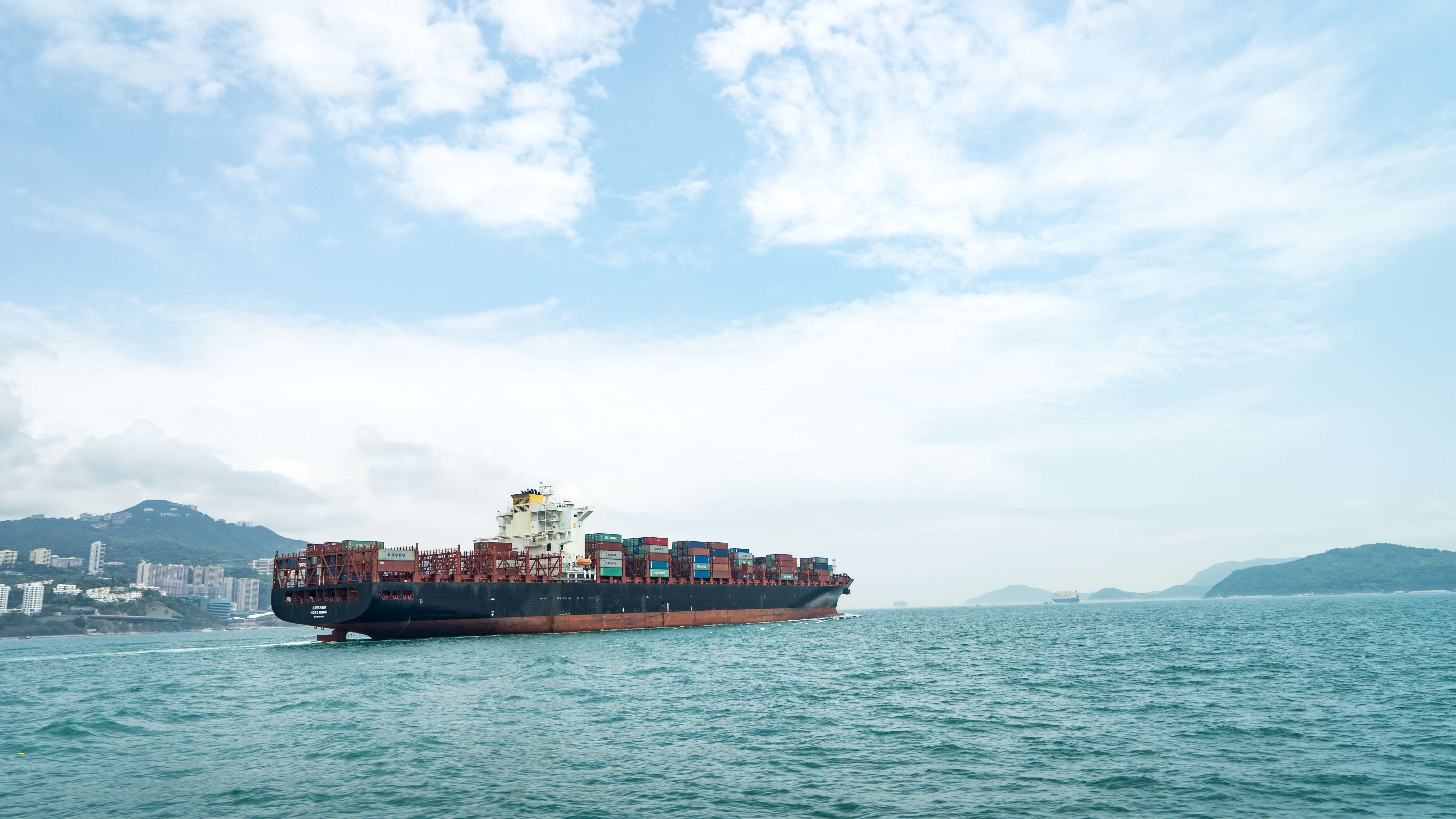
Floating around amongst the many confusing terms in logistics, specifically within shipping and the many documents therein, is the telex release. In a perfect world, a shipment would go smoothly from shipper to receiver- every time. But since we have to consider the risk factors inherent in life, such as loss, theft, damage and disputes, etc., the need arose for a solution to mitigate these risks: paperwork. And while paperwork has drastically helped in the shipping process, we still need technological aid to supplement the shortfalls of physical paperwork.
What is a telex release?
When a Bill of Lading (B/L) is issued, there are only 2 ways the cargo will be released:
- by an endorsed OBL
- with a telex release
A telex release is in essence an electronic message transmitted from an agent or shipping line at the port of loading (POL) to the agent at the port of discharge (POD). This message signifies that the shipper has surrendered the original Bill of Lading (OBL). For a telex release to be actioned, there are a couple criteria that must be met.
Firstly, an original, physical B/L was issued, printed and subsequently surrendered. Furthermore, the surrendered B/L was originally issued as a Straight B/L. The outcome of a successful telex release situation is the release of cargo to a consigneeWhat is a consignee? When transporting freight (by ocean, air, or land), there are two parties involved — one who is shipping and the other who is receiving the freight. The recipient of the goods b... More without the presentation of the endorsed OBL.
Here, you can see the basic process in a simplified diagram:

In order to understand what a telex release is, it is essential to understand the purpose of a Bill of Lading.
A Bill of Lading is a document which is intended to be a protection tool for the shipper. It serves as proof of ownership, contract of carriage and a receipt of shipment.

Bills of lading can be categorized into negotiable and non-negotiable.
By default, the B/L is a non-negotiable document- as it is classified as a document of title (ownership). It is also called a “Straight Bill of Lading”. There is another type of B/L which is negotiable, and it becomes this type when it states that the goods are to be delivered “to bearer or to the order of” a named person. With regard to telex release, this an important consideration, as it is typically only relevant when the B/L is issued as a Straight Bill of Lading (non-negotiable document of title)- though exceptions have been cited to exist.
Within the shipment process, this critical document must accompany the product and be endorsed by the each of the parties involved in the process: the shipper, carrier, and receiver. The carrier issues the original Bill of Lading document to the shipper of the goods as soon as their shipment/consignment is laden (loaded) on board. The shipper then sends the OBL to the receiver or consigneeWhat is a consignee? When transporting freight (by ocean, air, or land), there are two parties involved — one who is shipping and the other who is receiving the freight. The recipient of the goods b... More of the shipment using a courier. You can see this basic process in the diagram below:

Why would a shipper surrender the original bill of lading?
There are a few instances in which the surrender of an original Bill of Lading could be an appropriate course of action in the shipping process.
Time Pressure
The shipper carrying the cargo has arrived to the destination before the OBL has reached the consigneeWhat is a consignee? When transporting freight (by ocean, air, or land), there are two parties involved — one who is shipping and the other who is receiving the freight. The recipient of the goods b... More. Moreover, the documents will not arrive and get cleared before the expiry of the consignment’s free-days.
Internal Processes
The telex release may sometimes be requested for by a NVOCC operator to a shipping line, in order for them to issue their house B/L to their customer.
Cost Savings
Payment for the consingment has been received by the shipper and they want to save on courier fees.
Change
The OBL is lost or critical information on the OBL is no longer accurate.
How to send a telex release
In the past, telex releases were transmitted via telegraphic exchange machine, hence the name “TelEx”. These were more difficult to request and obtain. In modern times, shipping liners often provide the possibility of requesting a telex release on their online platforms. Unfortunately, we still haven’t reached the optimal level of convenience, so the task of checking with the issuer of the OBL to confirm the specific process lays on the shipper.
Telex vs express release
Perhaps you’ve also heard of the term “express release” as well. These are actually not one in the same. An express release can be in paper form or electronic as well, however the main difference between a telex release and an express release brings us back to the OBL.
Was an OBL issued, printed and endorsed?
If yes, then an express release is not applicable. An express release is used when there is no OBL.
Why wouldn’t there be an OBL?
Consider a situation in which the receiver of the shipment is a business counterpart of the shipper or there is a strong business relationship and a high level of trust between the two. In a case such as this, there isn’t much need for the shipper to generate this specific document for the sole purpose of securing payment.
Note that an express release can have different names. One well-known document, the Seaway Bill, is an excellent example. This is a type of express release and not an OBL.
What are the risks?
Although a regular activity within liner shipping, there is nevertheless a risk factor associated with the actioning of telex releases.
Another interesting consideration is whether or not the discharge of cargo via telex release is even allowed at the specific port authority.
In the times of telegraphic exchanges, forged documents were sent over by crooks in efforts to steal the cargo. Today’s technological advances have not necessarily increased security. Aside from fraud, the other major risk is the susceptibility to confusion. If the telex release is sent as an email, ambiguous writing can lead to misinterpretations and thus the discharge of cargo to the wrong place or wrong person.
Below are two separate examples of real cases published by a shipping insurance provider, ITIC.
Example 1: Human Error
Two containers arrived at a port in the Netherlands. Both containers were sent by a single shipper and were consigned to the same company. The shipper issued a telex release instructing the load port agent to release only one of the containers. This message was then passed to the discharge port agent, who erroneously released both containers. At this time, the consigneeWhat is a consignee? When transporting freight (by ocean, air, or land), there are two parties involved — one who is shipping and the other who is receiving the freight. The recipient of the goods b... More hadn’t paid for the second container. Eventually, lawyers, on behalf of the shipper, had to get involved in an effort to recover the value of the cargo in the second container. The value of the cargo amounted to 76,000 euros. After negotiations, the shipper was only able to recover 66,000 euros from the discharge port agent.
Example 2: Email Ambiguity
A single container was sent to the UK from a Singapore shipper. It had not been paid for by the original consigneeWhat is a consignee? When transporting freight (by ocean, air, or land), there are two parties involved — one who is shipping and the other who is receiving the freight. The recipient of the goods b... More in the UK and another buyer was found in South Africa. After reaching the UK, the shipper requested that the consignment be shipped from the UK to South Africa. The shipping line agreed to a change of destination (COD), on two conditions:
- the shipper pays additional freight
- the shipper surrenders the OBL issued in Singapore in exchange for a new OBL indicating the new POD
The Singapore agent sent an e-mail telex release to the UK agent which stated: “Shipper has confirmed COD charges and bills are now surrendered. Please kindly go ahead, Thanks.” A UK agent interpreted the “go ahead” to mean the consignment could be released to the original UK consigneeWhat is a consignee? When transporting freight (by ocean, air, or land), there are two parties involved — one who is shipping and the other who is receiving the freight. The recipient of the goods b... More without collecting the original bills of lading. The “go ahead” actually meant that the consignment should be shipped to South Africa. The contents of the container were highly valuable goods and a claim was filed thereafter.
Mitigation strategy
One method that shipping companies are using to mitigate risk is by providing shippers with the ability for importers and exporters to request for a telex release through their integrated online platforms. The image below shows the result of an electronic telex release generated on the Yang Ming’s Web Telex Release System.

Digitalization and standardization are making strides, but we a still have a long way to go before we reach virtually errorless shipping processes.




